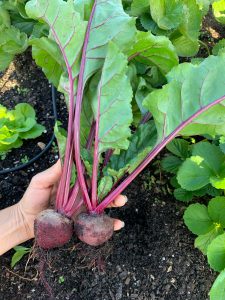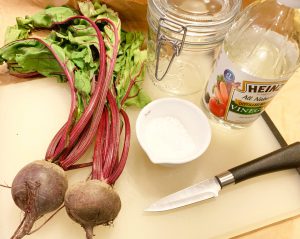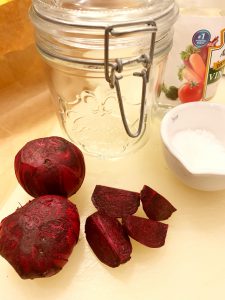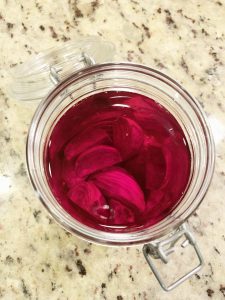Authors: Naima Ibrahim, Virgilia Zabala

Beets (Beta vulgaris) are root vegetables with a distinct red-purple hue that are chock full of nutrients and easy to grow in a Florida garden. To do so, simply begin by planting seeds during October and continue to do so every 3 weeks until February (UF IFAS Gardening Solutions, 2018). Research has classified beets as a superfood, being within the top ten plants with the highest antioxidant activity and also rich with minerals such as potassium, sodium, phosphorous, calcium, magnesium, copper, iron, zinc and manganese (Mirmiran et al., 2020). There’s extensive research that has been done on beetroots to determine the numerous health benefits they can provide including anti-inflammatory and vascular-protective effects, improved brain health and athletic performance, among many more (Clifford et al., 2015).
Despite being such a rich plant, beets aren’t often seen on the day-to-day plate of the average person, and there may be a reason why. According to the New York Post, a recent survey conducted by Veggie Tracker found that for U.S. adults, beets are the second least-liked vegetables to consume (2019). The earthy flavor of the vegetable appears to be a deal breaker. So, what can be done to increase the consumption of this extremely beneficial vegetable while also sidestepping the obstacle of flavor? One answer is pickling.
Pickling is the process of preserving food by placing it in a vinegar solution. This process can extend how long your vegetable will keep and alter its flavor. Note that the pickling process will differ if your goal is to achieve a shelf-stable product.
So, whether you’ve grown your own beets or purchased some from a local farmer’s market or grocery store, we will provide an easy-to-follow recipe for making your own pickled beets to help you work this superfood into your diet.
Refrigerator Pickled Beets
Please note, these are not shelf-stable and must be kept under refrigeration for food safety.

Basic Ingredients and Materials:
- Fresh beets
- Distilled white vinegar (5% acidity or higher; acidity should be labeled on the vinegar).
- Water
- Kosher salt
- (Optional) Any spices for flavor: peppercorn, mustard seeds, pepper flakes, chilies, etc.
- Knife
- Cutting Board
- Medium sauce pan
- Clean glass jar with a lid
Instructions:

- Remove the stems off of the beets and peel their skin. Cut into the shape of your choice (wedges or slices). Be careful as the vegetable easily stains!
- Combine water and vinegar in a 1 to 1 ratio, e.g. 1 cup of water and 1 cup of vinegar.
- Add your water/vinegar combination to a sauce pan and place it on the stovetop at medium heat.
- Sprinkle a teaspoon of kosher salt into the pan. If you don’t have kosher on hand, ideally a salt with no additives can be used. Bring the solution to a simmer for two minutes, until the salt dissolves. Allow the solution to cool.
- Place your cut beets into the glass.
- Carefully pour the salt vinegar solution into the glass jar with the beets once the solution has cooled.

7. Optional: Add spices of your choice. Examples include peppercorns, mustard seeds, pepper flakes, or chilies.
8. Seal the jar. Place into the refrigerator for 24-48 hours and then enjoy!

There are many different ways to eat your beets. Slice them with some boiled eggs, chop them up and sprinkle some feta, or place them into any salad for some color and flavor. Your pickled beets should last for 1-2 weeks!
Shelf-Stable Pickled Beets (canned)
These pickled beets do not need to be refrigerated prior to opening. For a recipe on how to prepare shelf-stable pickled beets, use this recipe from the National Center for Home Food Preservation:
https://nchfp.uga.edu/how/can_06/pickled_beets.html
For more information on pickling and different recipes, visit the National Center for Home Food Preservation (https://nchfp.uga.edu/how/can6b_pickle.html)
Sources:
Clifford, T., Howatson, G., West, D. J., & Stevenson, E. J. (2015). The potential benefits of red beetroot supplementation in health and disease. Nutrients, 7(4), 2801–2822. https://doi.org/10.3390/nu7042801
Mirmiran, P., Houshialsadat, Z., Gaeini, Z., Bahadoran, Z., & Azizi, F. (2020). Functional properties of beetroot (Beta vulgaris) in management of cardio-metabolic diseases. Nutrition & Metabolism, 17, 3. https://doi.org/10.1186/s12986-019-0421-0
SWNS. (2019, June 17). These are America’s favorite vegetables — and most hated. New York Post. https://nypost.com/2019/06/17/these-are-americas-favorite-vegetables-and-most-hated/
UF IFAS Gardening Solutions. (2018, Feb. 19). Beets. https://gardeningsolutions.ifas.ufl.edu/plants/edibles/vegetables/beets.html
Michigan State University. (2015, May 6). Refrigerated Pickled Spring Vegetables. https://www.canr.msu.edu/news/refrigerated_pickled_spring_vegetables
 0
0
